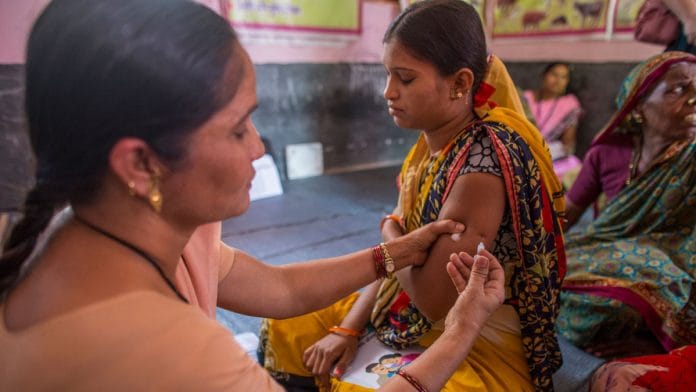Mumbai: Health workers deployed in the grassroots need to be trained in medical abortions to ensure women don’t approach quacks in the absence of doctors, medical professionals have suggested.
However, this should only be an emergency fix that is not exercised beyond the ninth week of pregnancy, they cautioned.
Medical abortions are a non-surgical way to terminate pregnancies that involve the use of medicines.
It is believed that the majority of Indian women looking to undergo abortions do so by self-medication or through quacks owing to the stigma and lack of awareness surrounding such procedures.
“The requirement of training for those who are not qualified doctors is because we don’t want any patient to go without a proper medical abortion,” Dr Bharti Maheshwari of the Federation of Obstetrics and Gynecological Societies of India (FOGSI) told ThePrint.
FOGSI is a professional organisation that seeks to represent obstetricians and gynaecologists.
“As there is a shortage of doctors, for the time being, we can’t do this. So, temporarily, till the doctor-patient ratio improves, there should be professional help at the level of ASHA [government-accredited social health activists], auxiliary nurse midwives, and AYUSH doctors [who practise ayurveda, yoga, unani, siddha and homoepathy),” she added.
Maheshwari was talking to ThePrint on the sidelines of a session titled ‘Medication Abortion – Act, Enable, Influence’ at ‘Dialogue 2019 – Engaging in a Dialogue that Moves Us Forward’, organised by the Mumbai Obstetrics and Gynaecological Society in the Maharashtra capital.
Also read: Busting abortion myths in India on International Safe Abortion Day
‘Only way out’
There was a consensus among participating doctors at the event, held this weekend, that besides the associated stigma and myths, the lack of gynaecologists and obstetricians was a major reason why women opted for abortions outside medical facilities.
Dr Basab Mukherjee, a FOGSI regional coordinator for the prevention of unsafe abortions who was moderating the session, cited a study published in The Lancet to point out that as many as 78 per cent of abortions in India were carried out outside health facilities.
“Medication abortion is the only way out because we have failed the women,” he said at the event.
“They do it with self-medication. Information dissemination by creating awareness would help, but in no way over the next 15 years will we be able to provide safe abortion facilities for [all] women,” Mukherjee added.
“What can be done to prevent mishaps is that 78 per cent of these women should be knowing whom to approach, how to correctly administer the medication, and where to go in case of any problem,” said Dr Arun Nayak, a former president of the Mumbai Obstetrics and Gynaecological Society.
Talking about the stigma associated with abortions, Vinoj Manning, the chief executive officer of the Ipas Development Foundation (IDF), an organisation engaged in providing abortion care and guidance, said “at least 58 per cent of women considered abortions a sin and 38 per cent said they will stop being friends with those who had had abortion”.
According to Maheshwari, women were often driven by this stigma to hide an unwanted pregnancy from even their husbands and seek counsel from others.
“When they go to some contraception provider, they are told, ‘why don’t you take contraception, abortions are bad’, and get shouted at, so most of them go to ASHA workers, midwives…” Maheshwari added.
But since these health workers are not equipped with the right training, the women are forced to look for other means.
“They approach either the elder women in their family or quacks in the neighbourhood. Whatever they direct, the women follow,” she said. “Without medical supervision, they are not even aware whether the pregnancy gets terminated or not. This can result in ectopic pregnancies and the results are life-threatening.”
Ectopic pregnancies are those that see the fertilised eggs attach outside the uterus, with possibly grievous complications for mothers.
Also read: Abortion has been legal in India since 1971 but it is still not a woman’s right
Cautious approach
According to Maheshwari, the Medical Termination of Pregnancy (MTP) Act 1971, which oversees abortions in India, should provide for trained health workers on the ground to offer abortions till nine weeks and state clearly that any termination beyond that period be under a doctor’s supervision.
“Mid-level workers can’t decide whether the patient needs a surgical abortion,” she added. “[Under the MTP Act] The abortion can be done till 20 weeks but it gets a little complicated and a proper ultrasound test is required to detect the condition of pregnancy…” she said. “Only a doctor can observe the ultrasound and take a decision, no one else.”
The MTP Act allows the termination of pregnancy till 20 weeks. It is only in the event of a mortal threat to the mother’s life that abortions can be pursued in subsequent weeks.
The Union Health and Family Welfare Ministry has prepared a draft amendment bill that seeks to push the ceiling to 24 weeks, besides allowing healthcare providers like nurses and AYUSH practitioners to offer abortion services — demands similar to the kind proposed by the doctors at the event. However, the bill is yet to see the light of day.






